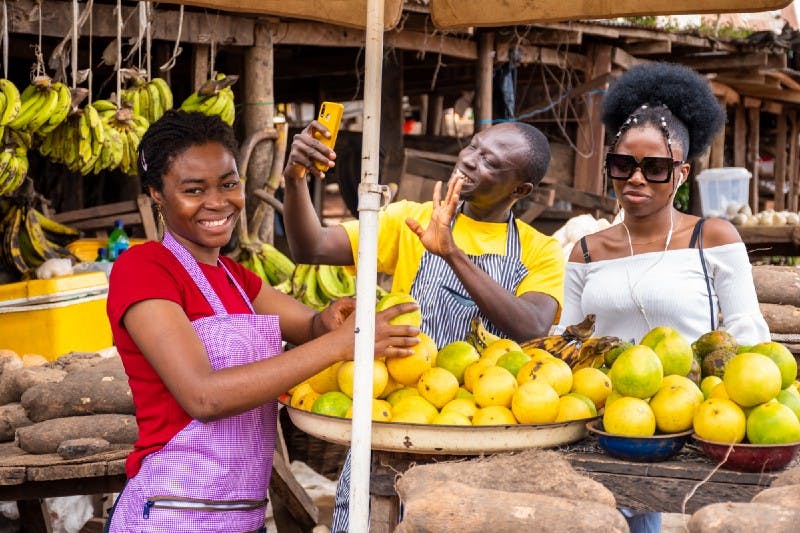The World Bank reported in 2018 that about 1.7 billion people globally lack any form of financial account. In 2021, 57% of Africa’s population remained underserved, estimated at 95 million people– who do not have a traditional bank account.
Financial services prominently steer the functioning of markets and economies. Financial products such as credit and insurance create friendly settings for business transactions. These promote domestic and international transactions, facilitate and conduct domestic savings, and help households and SMEs access credit. They achieve these through diverse banking securities and insurance services.
The majority of underserved groups cannot contribute to the economy because they lack access to financial services. This provides the continent with fewer economic options for serving its citizens.
Understanding the financially underserved in Africa
What Does “Underserved” Mean in Finance?
The term “underserved” encapsulates two other terms in finance– “unbanked” and “underbanked.” These three terms describe individuals with very low access to financial services. However, they differ slightly from one another.
The term unbanked describes individuals financially excluded from the mainstream financial system. These individuals own no form of account at a bank.
The underbanked may have a bank account but have limited access to conventional financial services. Hence, they depend on alternative financial services from non-banks.
The unbanked and underbanked fall under the umbrella term underserved. The financially underserved have low or zero usage or access to financial services and receive poor financial products and service delivery. Today’s world requires financial products and services to meet needs. Day-to-day activities involve business transactions, payments, savings, credit, and insurance. The financially underserved lack access to these useful and affordable financial products and services. And the underbanked with very little access is not served sustainably and credibly.
How Do They Meet Their Needs?
Consequently, they employ alternative financial services such as check cashing institutions and money order providers outside of a bank. Other alternatives include payday lenders, pawnshops, rent-to-own services, auto title lenders, and tax anticipation lenders. In addition, age-long financial practices such as peer-to-peer saving circles, e.g., Ajo (Nigeria), Stokvel (South Africa), and Tontines (Mali), still serve many Africans today.
Financially Underserved– By Choice or Circumstance?

Although several countries in Africa embarked on efforts to include more citizens financially, more than one-third of the population is still financially underserved. Not all unbanked Africans choose not to own a bank account or use traditional financial institutions. The financially underserved in Africa cannot be adequately included and served without understanding why so many people are still unbanked or underbanked in 2022. Physical, economic, regulatory, and cultural factors influence the lack of access to financial services. Hence, the financially underserved predominantly include the poor, the disabled, women, the young, rural communities, and those in the informal economy.
The following sub-factors influence the financially underserved:
Illiteracy and Education
Due to illiteracy and poor western and financial education, some are unaware of the need for financial accounts. Some individuals also mistrust traditional financial institutions and prefer to patronize or employ alternatives.
Gender Bias
Gender inequality contributes to the population of financially underserved people in Africa. Women in poor households, rural areas, and retired groups constitute about half of the unbanked population. According to the World Bank, countries with high financial account ownership have less gender inequality. However, in many parts of Africa, women possess little to no control over their economic lives or even family finance. The gender gap in account ownership in Africa increases financial exclusion.
Service Delivery of Financial Institutions
Every customer desires quality delivery of services and products. Unfortunately, bad experiences with financial institutions influence certain decisions to become unbanked. Mistrust, privacy concerns, and high bank fees also top the list of why people don’t have bank accounts.
Rural/Remote Environment
Rural areas often lack physical infrastructure, such as commercial banks. As a result, residents of rural communities are largely financially underserved. They often lack financial information, education, and institutions due to their geographic location. More so, their environment predominantly influences their financial decisions, choices, needs, and activities.
Access to Internet
Digital technology is one of the key players in expanding financial inclusion. Access to financial technology and even information requires the Internet. However, it is astonishing that not all Africans have access to the Internet or a gadget capable of connecting to the Internet.
Low Income and Cash Flow
Individuals and businesses with access to very low income might feel that they do not require to open or use a financial account. They access only a small amount of income at a time, receive, save, and spend mostly in cash– leaving insufficient money to meet minimum account balance requirements. As a result, the poor constitute a large fraction of the financially underserved. 35% of adults in low-income countries opened their first financial account to receive government funds, payments, or incentives. For many, it remained their only financial account.
Serving the Financially Underserved in Africa Through Financial Inclusion

Experts identify financial inclusion as an enabler for seven of the 17 Sustainable Development Goals (SDGs). Financial inclusion also holds the key to poverty alleviation and attaining inclusive economic growth in Africa and other developing economies.
Several countries launched or began developing national financial inclusion strategies to reduce the population of financially underserved individuals in their nation. Below are some of the ways the financially underserved are deprived and how they can be served.
Breaking Physical and Economic Barriers
Rural, low-income and less educated communities concentrate on the financially underserved population. They often lack access to physical infrastructure, financial information, and economic power. Innovative services, such as digitally-enabled payments and mobile banking, significantly overcome economic barriers to financial access, especially for inhabitants of remote and rural areas.
Physical barriers such as location, distance, gender, and age have been overcome. Financial products and services have been made easily accessible anywhere, anytime, and by almost anyone. Mobile technology provides affordable features and tools for expanding financial access in these areas. Mobile accounts are inexpensive and can even contain elements that personalize user experience. It delivers a range of financial services and products to locations without physical infrastructures, such as banks. However, financial education and IT training are essential because illiterates and the elderly form a significant part of the financially underserved.
Private Sector Innovation and Financial Technology
Financial inclusion may be increased through the deployment of innovative technology and business concepts. New business models such as e-commerce create new marketplaces for transactions, accumulate databases, and other features with potential that can be leveraged for financial inclusion. The private sector’s adoption of business models that support technology platforms intensifies the impact of new technologies. For instance, innovative insurance products can curtail weather-related risks in agricultural production to facilitate investment and productivity for farmers.
Financial technology (Fintech) solutions assist the financially underserved — including small business owners and “unbanked” individuals to gain and improve their financial literacy, money management skills, access to funds, and build a credit history. It boosts economic growth because more financial transactions and a financially literate population yield a more resilient and inclusive economy. Fintech also offers non-cash payment options for unbanked individuals.
National Financial Inclusion Strategies (NFIS)
Governments need to develop and implement well-designed inclusive policies. Countries with significant progress in financial inclusion developed NFIS discussions with diverse stakeholders, including financial regulators, telecommunications stakeholders, finance, and education ministries.
Practical regulatory frameworks, incentives for the extension of affordable financial services, and interventions (like financial education and consumer empowerment) that expand the demand for these services help serve and include the financially underserved in the economy. Government funding, payments, and incentives can be leveraged to bring on and serve the financially underserved, especially in rural areas. A government that financially supports citizens encourages financial participation.
Consumer Protection and Financial Capability
Financial services are meant to be sustainable and credible. A financial institution that pays attention to consumer protection and financial capability delivers better service to its customers. It also imbibes the trust of traditional financial institutions in them.
How Does This Affect the Continent?
The financially underserved as part of the population influence the economy even though they cannot thoroughly contribute to its druthers.
Besides facilitating daily living, access to affordable financial products and services creates financial opportunities for individual, corporate and national economies. Individuals and businesses as account holders are more likely to employ various financial services and contribute to the economy. Credit and insurance aid and fund business start-ups and expansion. Other financial services also make investments in education, health, and risk management easier. The usage, quality, and affordability of more financial products and services by more people improve the quality of life. These increase the momentum and impact of reforms and make the economic situation of Africa better.
Final Note
Financial inclusion bridges the rich-poor gap and promotes financial inequity in a nation or continent. It leads to poverty alleviation, economic and social development, and financial stability. The clamour for inclusive economic growth in Africa hinges on the inclusion of the financially underserved. It involves bringing on the unbanked and serving the underbanked better with affordable and credible financial products and services. However, formulating sustainable, localized strategies for financial inclusion requires a thorough understanding of the financially underserved in Africa.
Oystr is using alternative financial data to solve the problem of financial inclusion in Africa and empower financial institutions to make better decisions. Visit us to learn more

